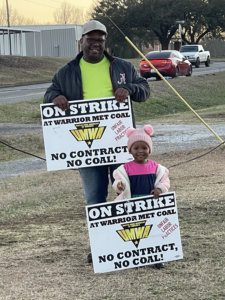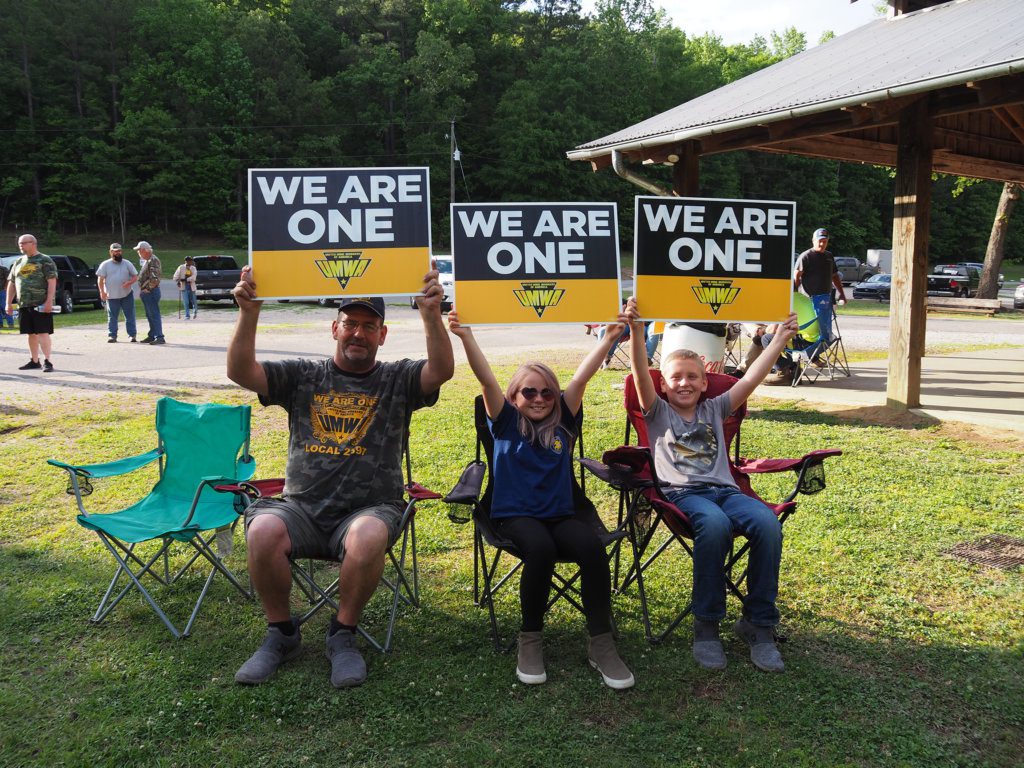
Source: al.com
March 31, 2022
“We didn’t want to do this.”
United Mine Workers of America International President Cecil Roberts said the words in thinking back on the last year, one day short of the first anniversary of the union’s strike against Warrior Met Coal.
It is believed to be the longest strike in Alabama history.
By all accounts, no one saw it lasting this long.
The work stoppage, the first for the Alabama miners in four decades, began April 1, 2021.
Roberts, who has been president of the union for the past 26 years, said today it was the first major strike of his tenure.
Several times over the last 12 months he had thought it was close to ending.
“It should have ended months and months ago,” he said. “In fact, quite frankly, I don’t think there should have been a strike in Alabama.”
Curtis Turner is the president of the Local Union 2427 Central Shop. He worked for 36 years in the mines and, like Roberts, never expected the strike to continue for a year.
“We’ve made this company one of the largest met coal producers and sellers in the U.S., and the company is very profitable,” he said. “I just cannot believe the company has taken this position. In my opinion, it’s just corporate greed.”
The old agreement with the union was negotiated as Warrior Met emerged from the bankruptcy proceedings of the former Walter Energy, which declared bankruptcy in 2016.
Union members say they made numerous concessions at that time in pay, benefits, holidays, overtime and in other areas to keep the company going and get it out of bankruptcy. Those concessions, they say, have not been restored in subsequent offers from the company.

According to the union, miners lost about $6 an hour under the bankruptcy contract, which added up even more when you consider the accumulation of overtime.
“We were basically promised back in 2016 that if we did this contract, that if we made the company viable over the course of that contract, we would go back to whatever everyone else is making and back to the benefit package,” Turner said.
“Then they told us, we don’t think we made those promises.”
In the tentative offer, the company proposed a $1.50 raise over five years, the union says.
“In my opinion, we had no other choice,” Roberts said.
Nearly two weeks into the strike, it appeared a settlement had been reached, but that was rejected after the union members voted down the tentative agreement by 95%, Roberts said.
Warrior Met Coal did not comment for this story.
The company established a website, Warrior Met Coal Facts, to counter what it says are misleading statements in the media by union members.
Warrior Met says it has put forward eight full written proposals for a new contract in the last year and offered a 10% to 12% raise.
Roberts counters by saying the eight proposals are virtually indistinguishable from the tentative agreement that was overwhelming voted down by the union last April.
According to the company, the proposed contract from April 2021 offered reduced deductibles and out-of-pocket expenses on healthcare, a policy that miners wouldn’t be scheduled for seven consecutive days unless the employee agreed, offered additional holidays, and increased the number of unexcused absences allowed.
The union says the strike has cost the company close to $1 billion in lost revenue.
It arrives at that figure based on the price of metallurgical coal, which is used in steel production. Last year, when the strike began, the price fluctuated around $100 per ton. Within the last month, the price soared to more than $400 per ton.
According to Warrior Met Coal’s quarterly reports, the company last year incurred $21.4 million in non-recurring expenses directly attributable to the strike for security and other expenses, and $33.9 million in idle mine expenses.

“While the Company has business continuity plans in place, the strike may still cause disruption to production and shipment activities, and the plans may vary significantly from quarter to quarter for the full year of 2022,” the company warned in its last earnings report in February.
When the strike was initially announced, as many as 1,100 members were said to have been participating. Roberts said the number is closer to 900, and about 15% have gone back to work over the past year.
According to Roberts, the union has provided just under $20 million to its striking members over the last year, including healthcare coverage, and has been able to pay about $1.8 million using contributions from other unions and private individuals. The union could continue to pay out strike benefits for the next four to five years, he said.
“If the company is trying to put us in a position where we couldn’t pay these workers strike benefits, that’s not going to happen,” he said. “They need to rethink that.”
Turner said morale among strikers remains high. Food banks continue to distribute to families, and members rally every week.
“The people are just looking for a decent contract and being able to go back to work,” he said. “They realize they’re sacrificing a lot but its for a better future for them. They’re pretty well pumped. We’re not going anywhere.”
The strike has had its volatile moments.
In October, Circuit Judge James H. Roberts Jr. issued a restraining order against picketing “or other activity” within 300 yards of 12 different locations owned by Warrior Met Coal in Tuscaloosa County, including mines and offices.
This came after the company issued a statement saying the level of violence taking place along the picket line in Tuscaloosa County had “reached a dangerous level.” The company also released video of car and truck windows being smashed that it says happened to workers attempting to cross the picket line.
Last May, nearly a dozen miners were arrested during a protest outside a mine. In June, union members reported at least three instances of violence along picket lines. The union also objected to the use of the Highway Patrol Division of the Alabama Law Enforcement Agency to escort miners across the picket line.
Just in the last week, the FBI began investigating a suspected attack March 24 using an explosive device to a Warrior Met Coal natural gas pipeline along Hannah Creek Road in eastern Tuscaloosa County. There were no reported injuries. That came after damage to electrical transmission and distribution equipment on the company’s property reported on three occasions last May and June.
The union has denounced such incidents. Roberts said he has “called for non-violence” throughout the strike.
“But our people are dodging cars out on the picket line,” he said. “They’ve had threats made against them by workers inside those facilities. They’ve had guns pulled on them. But they’ve endured all of that.”
Turner said union members continue to station people outside mining locations, honoring the restraining order while continuing a picketing presence.
“We have to carry our people, drop them off, and come back and pick them up,” he said. “Some of these locations are so remote that they don’t have cell phone service. It’s real tough on individuals to participate.”
The union hasn’t just confined its picketing activity to Tuscaloosa County. Last year, miners protested at the Manhattan offices of BlackRock, the largest shareholder in Warrior Met Coal, on three different occasions. At one protest, Roberts was handcuffed, along with five other people, as the union attempted to aim attention at the companies they say are responsible for the conditions that made the strike happen.
By spotlighting the role of private equity firms in business, the strike also gained the attention of Sens. Bernie Sanders (I-Vermont) and Elizabeth Warren (D-Mass). Last month, a Brookwood miner and Roberts testified before the Senate Budget Committee.
Roberts said the union remains ready to make a deal to get members back to work.
“Somebody on the other side has got to want a collective bargaining agreement,” Roberts said. “We could find a way to reach an agreement. It’s like dancing with ourselves.”

